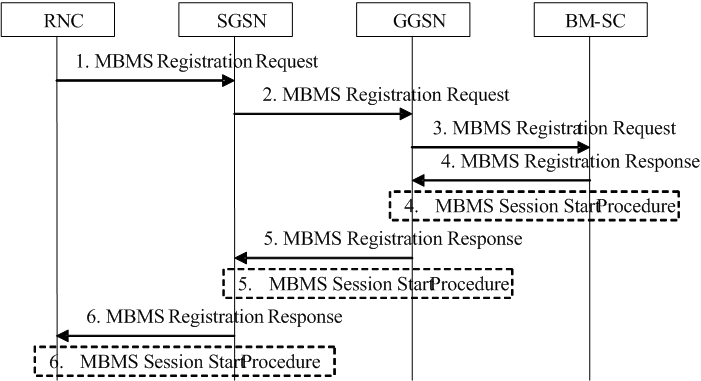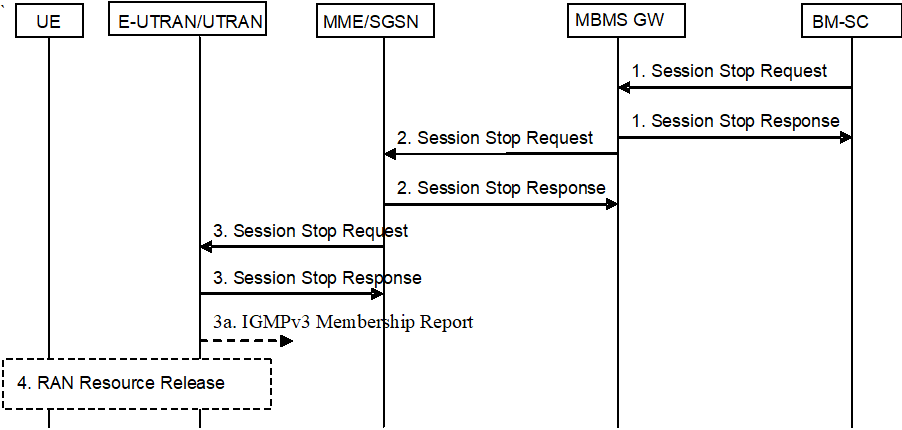Content for TS 23.246 Word version: 18.0.0
8.5 MBMS Session Stop Procedure
8.5.0 General
8.5.1 MBMS Session Stop Procedure for GERAN and UTRAN for GPRS
8.5.2 MBMS Session Stop Procedure for E-UTRAN and UTRAN for EPS
...
...
8.5 MBMS Session Stop Procedure p. 47
8.5.0 General p. 47
The BM-SC Session and Transmission function initiates the MBMS Session Stop procedure when it considers the MBMS session to be terminated. The session is typically terminated when there is no more MBMS data expected to be transmitted for a sufficiently long period of time to justify a release of bearer plane resources in the network. For GERAN and UTRAN for GPRS, the procedure is propagated to all SGSNs and GGSNs that are registered for the corresponding MBMS bearer service and to BSCs/RNCs that have an established Iu bearer plane with an SGSN. For E-UTRAN and UTRAN for EPS, the procedure is propagated to all MBMS GWs, MMEs and SGSNs that are registered for corresponding MBMS bearer service and to E-UTRAN/UTRAN that have accept to receive IP multicast distribution.
8.5.1 MBMS Session Stop Procedure for GERAN and UTRAN for GPRS p. 47
The overall MBMS Session Stop procedure is presented in the following Figure:

Step 1.
The BM-SC Session and Transmission function sends a Session Stop Request message to the BM-SC Proxy and Transport function, which forwards it to all GGSNs listed in the "list of downstream nodes" parameter of the affected MBMS Bearer Context to indicate that the MBMS session is terminated and the bearer plane resources can be released. The MBMS Bearer Context is uniquely identified by the TMGI or the combination of TMGI and Flow Identifier. The BM-SC Proxy and Transport function sets the state attribute of its MBMS Bearer Context to 'Standby'. The GGSN sends a Session Stop Response message to the BM-SC Proxy and Transport function, which forwards it to the BM-SC Session and Transmission function. The BM-SC Proxy and Transport function copies Session Stop Requests to the BM-SC Membership function for charging purposes.
Step 2.
The GGSN sends an MBMS Session Stop Request message to all SGSNs that have a bearer plane established with the GGSN, releases the corresponding bearer plane resources towards these SGSNs and sets the state attribute of its MBMS Bearer Context to 'Standby'. The GGSN releases the MBMS Bearer Context in case of a broadcast MBMS bearer service.
Step 3.
The SGSN releases the TEID and bearer plane resources on which it was receiving MBMS data from the GGSN for the affected MBMS bearer service and sends an MBMS Session Stop Request message to all BSCs/RNCs that have a bearer plane established with the SGSN and sets the state attribute of its MBMS Bearer Context to 'Standby'. The SGSN releases the MBMS Bearer Context in case of a broadcast MBMS bearer service.
Step 3a.
If the RNC/BSC is using IP multicast distribution it shall disable reception from the IP backbone of the particular MBMS bearer service according to RFC 3376, RFC 3810 and RFC 4604.
Step 4.
The RNC releases the affected radio and Iu resources; the BSC releases the affected radio resources. The BSC/RNC sets the state attribute of its MBMS Bearer Context to 'Standby'. The BSC/RNC releases the MBMS Service Context in case of a broadcast MBMS bearer service. A BSC in Gb mode shall send an acknowledgement to the SGSN even if there is no active MBMS context in the BSC.
8.5.2 MBMS Session Stop Procedure for E-UTRAN and UTRAN for EPS p. 48
The overall MBMS Session Stop procedure is presented in the following Figure:

Figure 10b: MBMS Session Stop procedure for E-UTRAN and UTRAN for EPS
(⇒ copy of original 3GPP image)
(⇒ copy of original 3GPP image)
Step 1.
The BM-SC sends a Session Stop Request message (MBMS data transfer stop, ...) to the MBMS GW listed in the "list of down stream nodes" parameter of affected MBMS Bearer Context to indicate the end of session and the bearer plane resources can be released. The MBMS Bearer Context is uniquely identified by the TMGI or the combination of TMGI and Flow Identifier. The BM-SC sets the state attribute of its MBMS Bearer Context to 'Standby'. The MBMS GW responses with Session Stop Response and release its information regarding the session.
Step 2.
The MBMS GW forwards Session Stop Request message to the MME/SGSN which previously received the Session Start Request message, release the corresponding bearer plane resources to E-UTRAN/UTRAN and sets the state attribute of its MBMS Bearer Context to 'Standby'. The MBMS GW releases the MBMS Bearer Context in case of a broadcast MBMS bearer service.
Step 3.
MME/SGSN forwards Session Stop Request message to the E-UTRAN/UTRAN which previously received the Session Start Request message and sets the state attribute of its MBMS bearer Context to 'Standby'. Each E-UTRAN/UTRAN responds with Session Stop Response message to the MME/SGSN. The MME/SGSN releases the MBMS Bearer Context in case of a broadcast MBMS bearer service.
Step 3a.
If the E-UTRAN/UTRAN is using IP multicast distribution it shall disable reception from the IP backbone of the particular MBMS bearer service according to RFC 3376, RFC 3810 and RFC 4604. If several MBMS bearer services shares the same IP multicast address, the reception from the IP backbone shall only be disabled when the last MBMS bearer service that has used a shared IP multicast address is stopped.
Step 4.
The E-UTRAN/UTRAN releases the affected resources and removes the MBMS Bearer Context (in E-UTRAN) or sets the state attribute of its MBMS Bearer Context to 'Standby' (in UTRAN). For E-UTRAN the release of the radio resources are scheduled using the MBMS data transfer stop parameter if present. It may be provided by the BM-SC in the Session Stop signalling. The MBMS data transfer stop parameter is not used by UTRAN.